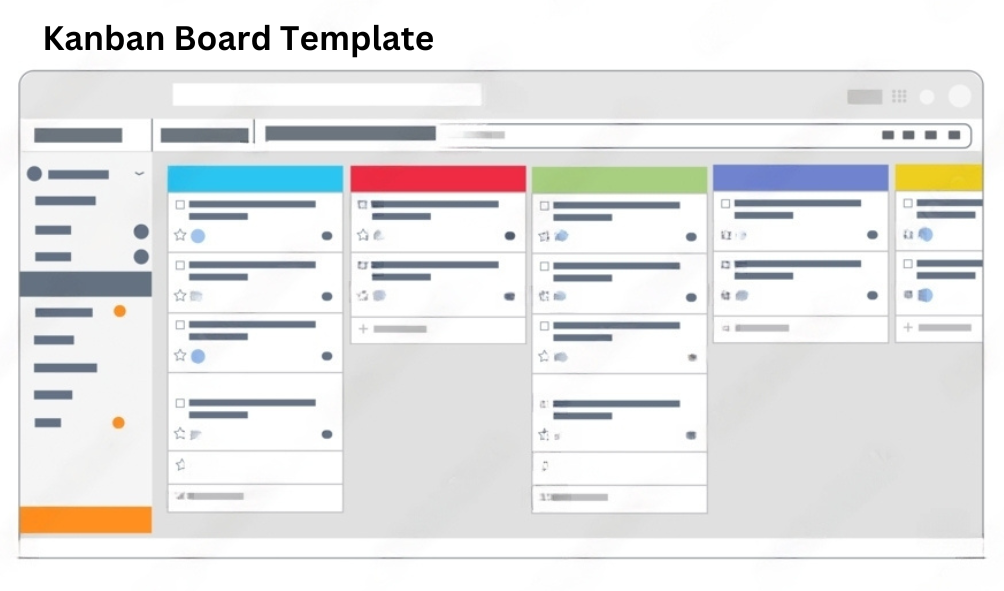Introduction to Kanban Template: Enhancing Workflow Efficiency
In today's fast-paced work environments, organizations strive to maximize productivity, streamline processes, and deliver high-quality results efficiently. One method gaining significant traction in achieving these goals is the Kanban system. Originating from Toyota's manufacturing processes, Kanban has evolved into a versatile tool applicable across various industries, from software development to healthcare and beyond.
At the core of the Kanban methodology lies the Kanban template, a visual representation of workflow designed to optimize task management, enhance collaboration, and foster continuous improvement.

Understanding the Kanban Template:
1.Visual Board Structure:
The Kanban template typically consists of a visual board divided into columns representing different stages of the workflow, from "To-Do" to "Done."
Each column contains cards representing individual tasks or work items, allowing team members to visualize the flow of work and track progress at a glance.
2.Work Item Cards:
Work item cards serve as the building blocks of the Kanban template, containing essential information such as task descriptions, assignees, due dates, and priority levels.
These cards are moved across columns as work progresses, providing a clear indication of the status of each task and enabling efficient task management.
3.Limiting Work in Progress (WIP):
One of the fundamental principles of Kanban is limiting the amount of work in progress to prevent bottlenecks and maintain workflow stability.
The Kanban template often incorporates WIP limits for each column, ensuring that teams focus on completing tasks rather than starting new ones indiscriminately.
4.Continuous Improvement:
The Kanban template fosters a culture of continuous improvement by encouraging teams to reflect on their processes, identify areas for optimization, and make incremental changes.
Regular reviews and retrospectives help teams refine their workflows, eliminate inefficiencies, and adapt to changing requirements effectively.
5.Visualization of Workflow:
By visualizing workflow on the Kanban board, teams gain valuable insights into task dependencies, workload distribution, and potential bottlenecks.
This visualization promotes transparency and enables proactive decision-making, allowing teams to prioritize tasks, allocate resources, and manage dependencies more effectively.
6.Flexibility and Adaptability:
The Kanban template offers flexibility and adaptability, making it suitable for diverse project management scenarios and work environments.
Teams can customize the Kanban board to align with their unique processes, workflow stages, and project requirements, ensuring optimal usability and relevance.
Implementing the Kanban Template:
1.Define Workflow Stages:
Begin by identifying and defining the key stages of your workflow, from task inception to completion. These stages will form the basis of your Kanban board columns.
2.Set WIP Limits:
Establish WIP limits for each column based on team capacity, resource availability, and project priorities. WIP limits prevent overloading and encourage focus on completing tasks.
3.Create Work Item Cards:
Create work item cards for each task or work item, including relevant details such as task descriptions, assignees, due dates, and any other pertinent information.
4.Visualize Tasks on the Board:
Place the work item cards on the Kanban board, organizing them into the appropriate columns based on their current status in the workflow.
5.Monitor and Manage Workflow:
Regularly monitor the Kanban board to track task progress, identify bottlenecks, and ensure adherence to WIP limits. Use the board as a visual tool for managing workflow effectively.
6.Iterate and Improve:
Encourage team collaboration and participation in continuous improvement efforts. Conduct regular retrospectives to reflect on process performance, gather feedback, and implement iterative improvements.
Benefits of the Kanban Template:
1.Increased Visibility and Transparency:
The Kanban template provides a transparent view of task status, progress, and workflow, enhancing visibility for team members and stakeholders alike.
2.Improved Workflow Efficiency:
By visualizing workflow and limiting work in progress, the Kanban template promotes smoother task management, reduces multitasking, and improves overall workflow efficiency
3.Enhanced Collaboration and Communication:
Kanban facilitates collaboration and communication among team members by providing a centralized platform for task tracking, updates, and discussions.
4.Flexibility and Adaptability:
The Kanban template's flexibility allows teams to adapt to changing priorities, requirements, and workloads dynamically, fostering agility and resilience.
5.Continuous Improvement Culture:
Through regular reviews and retrospectives, the Kanban template cultivates a culture of continuous improvement, empowering teams to identify opportunities for optimization and implement iterative changes.
6.Streamlined Decision-Making:
With real-time insights into task progress and workflow status, stakeholders can make informed decisions, prioritize work effectively, and allocate resources efficiently.
The Kanban template serves as a powerful tool for enhancing workflow efficiency, promoting collaboration, and driving continuous improvement within teams and organizations. By leveraging visual management principles and emphasizing transparency, flexibility, and adaptability, the Kanban template empowers teams to achieve their goals with greater clarity, focus, and effectiveness. Whether applied in software development, manufacturing, healthcare, or any other industry, the Kanban template offers a proven framework for optimizing processes and delivering value to customers and stakeholders.